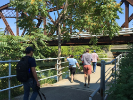Urban planning studio on Scajaquada Creek wins state planning award

Students traversed large sections of the Scajaquada Creek corridor to collect field data on the creek and its urban context. The resulting master plan offers detailed recommendations for daylighting the creek, or re-establishing the largely buried waterway as a cultural and natural resource for the community.
By Stephanie Bucalo
Release Date November 6, 2017 This content is archived.
A graduate urban planning studio’s plan for preserving the cultural and historical landscape of Buffalo’s Scajaquada Creek corridor has won the American Planning Association New York Upstate Chapter “Outstanding Student Project” award for 2017.
"Scajaquada Creek Uncovered: A Historic Cultural Landscape in the City of Buffalo" was researched and designed by the fall 2016 historic preservation studio led by clinical professor and preservation planner Kerry Traynor.
The Scajaquada Creek is a 16-mile waterway that runs east to west from the Town of Lancaster in Erie County, through the City of Buffalo, and into the Niagara River at Black Rock canal. Nearly four miles of the creek flow through underground culverts, hidden below roadways and urban development.
Traynor’s studio set the stage for students to explore a space that, while largely hidden to the naked eye, has greatly contributed to the economic and cultural growth of Buffalo throughout its history.
“The study of Scajaquada Creek is a consideration of cultural landscapes, where we begin to talk about the context in which we live - its sense of place and history – as an actual landscape,” says Traynor, who teachers the preservation planning studio annually.
The studio involved extensive field work, with students traversing the creek-bed to explore its natural and physical attributes and surrounding environment. Students integrated data and historical and field research into a master plan with detailed recommendations for "daylighting" portions of the creek, or re-establishing its landscape as a cultural and community oriented natural space.
Traynor says she challenged students to think beyond the visible and tangible evidence recorded in history books and archives. “[It] becomes this investigative process of understanding this resource, understanding how we begin to think about something we can’t see even though it is there. How do we offer ways of restoring it? How can we bring a presence and understanding that will allow people to consider what they have as a resource. Hopefully we can offer an opportunity for the Creek's literal daylighting sometime in the future.”
Bradley Everdyke, a member of Traynor’s studio and now a graduate of UB’s dual Master of Urban Planning/Master of Architecture program, reflects on the collective studio experience:
“The real power of the studio…was discovering or 'uncovering' the Creek and its history. The Creek is essentially invisible as it has been channelized, augmented, and covered by highways through its history. Because of this, however, the Creek is also a fairly good example of Buffalo's development through the 20th century – it has evolved and continues to be affected by the City's infrastructure.”
Everdyke cites the report’s important findings related to patterns of social and economic inequity along the Scajaquada corridor: “Rediscovering this 'natural' artery that crosses the physical, social, and economic borders of the city and reveals continued struggles with inequality is the most inspiring result of the studio. This offers exponential opportunities for the future in planning, policy, and design in the City of Buffalo.”
“The real power of the studio…was discovering or 'uncovering' the Creek and its history. The Creek is essentially invisible as it has been channelized, augmented, and covered by highways through its history. Because of this, however, the Creek is also a fairly good example of Buffalo's development through the 20th century – it has evolved and continues to be affected by the City's infrastructure.”
- Studio participant Bradley Everdyke (MUP/MArch '17)
The Scajaquada study is one in a long series of preservation planning studios led by Traynor that seek to uncover the historic and cultural contexts of buildings and landscapes throughout Buffalo. The studios have also examined historic neighborhoods in South Buffalo, Buffalo’s grain elevator district and the Paul Rudolph- designed Shoreline Apartments, with APA New York Upstate "Outstanding Student Project" awards also going to her studios on the grain elevators and a conservation district plan for Buffalo's Fruit Belt neighborhood.
The staple of the Master of Urban Planning curriculum is also core to the school’s historic preservation track within the Master of Science in Architecture and its advanced graduate certificate in historic preservation.
The American Planning Association New York Upstate Chapter presented the award to the School of Architecture and Planning at its 2017 Upstate Chapter Conference luncheon on October 13, 2017, in Syracuse, N.Y. This year’s awards program included eight different categories recognizing outstanding planning projects and planning professionals throughout the Upstate New York region.
View full list of award-winners
UB alumnus Brian Kulpa (MUP/MArch '03, BPS '00) was also honored by the APA New York Upstate Chapter with the "Distinguished Elected Official" award. Kulpa is mayor of the Village of Williamsville in Western New York.



